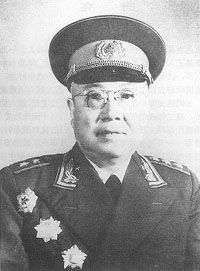Guo Tianmin
| Guo Tianmin | |
|---|---|
| 郭天民 | |
 | |
| Senior Department Head of the PLA National Defence University | |
|
In office 1958–1955 | |
| Chairman | Mao Zedong |
| Personal details | |
| Born |
7 May 1902 Huang County, Hubei Province, China |
| Died |
May 26, 1970 (aged 68) Guangdong, Guangzhou Province, China |
| Alma mater | Whampoa Military Academy |
| Awards |
|
| Military service | |
| Allegiance |
|
| Service/branch |
|
| Years of service | 1926-1989 |
| Rank |
|
| Commands | Red Fourth Army |
| Battles/wars | Guangzhou Uprising, Northern Expedition, Long March, Encirclement Campaigns, Second Sino-Japanese War, Chinese Civil War |
Guo Tianmin (Chinese: 郭天民; pinyin: Guō Tiānmín; 7 May 1902 – 26 May 1970)[1] was a general in the People's Liberation Army of the People's Republic of China from Hubei. He is the descendant of Guo Ziyi, a Tang dynasty general.[2]
Biography
Early Life
Guo had his primary education in the provincial agricultural school, and later enrolled into the Wuchang Zhonghua University's Affiliated Middle School. He returned to his hometown in Guangzhou in 1925, joining several local rebellions. In the following year, he enrolled into the Whampoa Military Academy. He joined the Communist Party of China in March 1927 and participated in the Guangzhou Uprising in December. After the rebellion failed, he retreated to Haifeng, successively becoming the platoon leader and deputy commander in the 2nd and 4th Divisions of the workers and peasants revolutionary army.[2]
In 1929, Guo traveled to Jiangxi to join the Red 4th Army and was appointed various positions such as division chief of staff and division commander. He was also made the chief of staff of the Jiangxi military region.[3] However, he was expelled from his positions after supporting Mao Zedong and thereafter went to the Moscow Sun Yat-sen University to further his studies. He returned in October 1933 to resist the Nationalist forces during the Encirclement Campaigns.[3]
In October 1934, he took part in the Long March. At Siduchishui, he helped Luo Binghui command of the 9th Red Army Corps in operations. In July 1936, he was appointed as the commander in the Red Fourth Army and West Road Army headquarters. In 1937 February, he became the chief of staff of the Red Thirtieth Army, ordered to advance towards Dihua, Xinjiang.[2]
During the Second Sino-Japanese War
In December 1937, he went to Yan'an and was appointed the secretary of war in the CPC Central Military Commission. In 1938 August, Guo was the Shanxi-Chahar-Hebei military region's chief of staff. Subsequently in December he was made the 2nd army division commander tasked to carry out the guerrilla war.[4] He participated in major campaigns such as the 1940 Battle of Niangziguan during the Hundred Regiment Offensive. His command post of the Hebei military region was shifted to Zhangjiakou after its occupation in August 1945.[5]
References
- ↑ 星火燎原编辑部 (2007). 中国人民解放军将帅名录 第一卷. 北京: 解放军出版社. p. 133. ISBN 7-5065-5031-8.
- 1 2 3 中国共产党新闻. "开国上将纪念馆-人民网". dangshi.people.com.cn. Retrieved 2016-11-20.
- 1 2 "郭天民:被朱德称赞为有功不居功的战将--中国共产党新闻-人民网". dangshi.people.com.cn. Retrieved 2016-11-20.
- ↑ 军事科学院军事图书馆 (200). 中国人民解放军全史(中国人民解放军组织沿革和各级领导成员名录). 北京: 军事科学出版社. p. 449. ISBN 7801373154.
- ↑ 2751. "哪位开国上将被国民党军敬畏地称为"铜墙"?--文史--人民网". history.people.com.cn. Retrieved 2016-11-20.